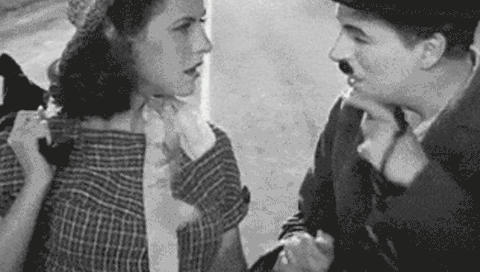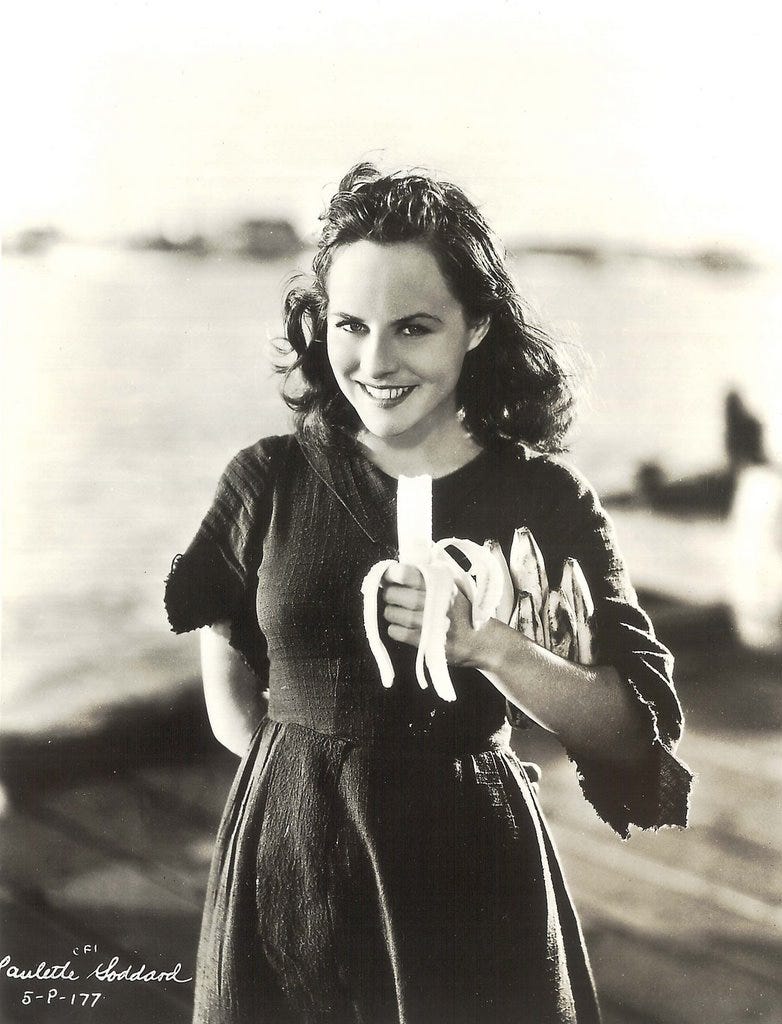GROSS/26 1936 BONUS - notes on a free spirit
I got distracted by Paulette Goddard, Charlie's co-star in Modern Times.
Paulette Goddard is another one of those paradoxical early Hollywood figures - not a great actor or an innovator, she doesn’t invent a performance style or a cinema archetype, doesn’t hypnotise us or haunt us like some of her contemporaries.
David Thomson says “she never quite carried a film or laid hands on unequivocal stardom.” But she brings confidence and directness to the films she’s in and that can transform them.
She’s Chaplin’s co-star in Modern Times. I mean to the extent anyone could possibly co-star with the most famous man on earth, with such an elevated, abstract figure. By Modern Times he was so not-of-this-world that it must have been a bit like co-starring with the Buddha or the white whale.
She alters the unalterable tramp. Goddard does a remarkable thing and, by virtue of her unselfconscious, joyful movement across the harsh backdrop of the film’s depression-era city, dislodges the tramp slightly from his elevated position. We don’t pity him as we do in his earlier movies - he has less of that martyred-saint vibe that some of us find irritating. This late-period tramp is apparently capable of a genuine human relationship. The fact that Chaplin and Goddard were dating (and would marry) must have helped.
In the film she plays ‘the gamin’. It means ‘urchin’ or ‘street kid’ in French. Victor Hugo gives about twenty pages to defining ‘gamin’ - in huge detail and along many dimensions - in his big novel of revolution Les Misérables - under headings like ‘He can be useful’ and ‘He is likeable’. Hugo’s gamin became a celebrity in his own right. His chapters were published separately as a book for children (he’s an important character in the international hit musical version). Without an ‘e’ gamin is a masculine word (and later, with an ‘e’, it would always mean Audrey Hepburn). Chaplin was literate, he knew all this, of course. I feel sure he knew this story. Hugo’s definition of the gamin works for Modern Times too:
…lives in gangs, roams the streets, sleeps rough, wears an old pair of his father’s trousers that come down over his heels, some other father’s old hat that comes down below his ears, a single brace made of a strip of yellow cloth; he gads about, keeps his eyes peeled, scrounges, dawdles, breaks in tobacco pipes, swears like a trooper, haunts the tavern, associates with thieves, back-chats with whores, talks slang, sings dirty songs, and has not an ounce of wickedness in his heart.
In Hugo’s book, a gamin becomes an important figure in an insurrection - a joyful, cheeky revolutionary called Gavroche - spontaneity, youth, naivety set against the grim-faced earnestness and pessimism of the older revolutionaries and the soulless barbarism of the state they fight. This gamin becomes a tragic mascot for the men building and guarding one of the mighty Paris barricades. He skips joyfully around it and over it - magically evading death in a barrage of shot from the soldiers until he doesn’t any more and is killed right there in front of his comrades, just when they’d convinced themselves he was invulnerable. Their resistance collapses and the barricade is over-run.
Goddard’s gamin roams the city, like Hugo’s. An opportunist, skipping along the dock edge and through alleys, joyfully harvesting firewood (and bananas liberated on the wharves) for her hungry siblings. She owns the city like Hugo’s gamin, unselfconsciously, in bare feet. Later on she tries to make an impossible home in a classic Chaplin comedy shack down by the shore. It’s the perfect home for a Gamin who lives for joy and not for ease but, of course, the shack has no function but to provide Chaplin with a sequence of collapsing chairs and falling beams and, inevitably, a back door that opens directly onto the water for extra convenience.
There’s more terrible dancing. Later the gamin charms her way into a job as a cafe dancer (honestly, she’s a terrible dancer) and persuades her new boss to take on the tramp as a waiter (he’s a terrible waiter too).
She’s hyper-connected. Paulette Goddard and Chaplin together form a powerful six-degrees node. There are many mad connections to be made. She married Chaplin and also, 20 years later, German novelist Erich Maria Remarque. She left her millions to New York University to fund an institution devoted to European studies, named for Remarque - the first director was British historian Tony Judt. If you want to connect Fatty Arbuckle with Jean-Paul Sartre or Diego Rivera with Jacques Derrida or Andy Warhol with Chiang Kai-shek you’ll do it in a few steps via Goddard.
In life Paulette Goddard was something of a gamin too. Although she never lacked for money - even as a child she met big stars and made showbiz connections through her flashy great-uncle Charlie Goddard, who owned drug stores and threw big parties. Her life seems honestly to have been directed principally by what was most fun. She didn’t become Rita Hayworth or Bette Davis but that doesn’t seem to have bothered her. When she gave up the movies and moved to Switzerland with her sophisticated new literary husband it was because she was bored. Her later life was basically a string of glamorous parties and thrilling journeys. Go Paulette!
Here’s my post about Modern Times.
As you may have noticed I consider this newsletter to be a kind of chronicle of terrible dancing in early cinema. See also: Broadway Melody, Aloma of the South Seas and The Jazz Singer.
I noticed, on the official Charlie Chaplin site, that Goddard in Modern Times has become the feminine ‘Gamine’. I wonder if there’s some discomfort about Chaplin’s use of the masculine? Was it a little too transgressive? A bit too close to Hugo’s revolutionary? Or did they assume that Chaplin’s French was rubbish?
The Penguin edition of Les Misérables is lovely and has an up-to-date translation, by Barbara Kovich. The introduction and the footnotes, which take up a third of the book, are a short course in French history in their own right. Also, it’s 365 chapters long so if you read a chapter a day you know how long it’ll take you!
Here's a list of all the top-grossing films since 1913 and here's my Letterboxd list.
And here’s another top-grossing list.









Paulette Goddard was in 'The Snoop Sisters' with Jill Clayburgh, who was in 'Starting Over' with Kevin Bacon.